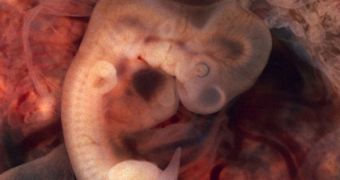A group of researchers studying human embryos during a phase of the development process called cleavage stage embryo determined that the three-day-old structure was capable of undergoing a process called genetic normalization.
When conceived from a fertilized egg, an embryo can be produced with an incorrect number of chromosomes in tow. This condition is called aneuploidy, and can be very dangerous if it persists.
There is no medical way of interfering with the disorder, but apparently the embryo can take care of itself in some situations. Experts from the Johns Hopkins Medical Institutions, in Baltimore, Maryland, found that the structure can spontaneously repair itself.
The process is called genetic normalization, and tends to last about two days. At fay five, the embryo enters its blastocyst stage and, by that time, the repair mechanism already converts it into an euploid. This means that it features the correct number of chromosomes.
The announcement was made by the senior author of the new study, professor William G. Kearns, in front of colleagues gathered at the annual meeting of the European Society of Human Reproduction and Embryology, Science Blog reports.
According to the expert, the research has significant implications for the future of stem cell therapy. Using the new knowledge, it may be possible to create stem cell populations capable of addressing conditions such as hematological disorders and neurological damage.
The work could also be useful for improving preimplantation genetic screening (PGS). Women have to take these tests before they undergo in-vitro fertilization. The health of their babies depend on PGS.
Kearns, an associate professor in the Johns Hopkins Department of Gynecology and Obstetric, is also the director of the Shady Grove Center for Preimplantation Genetics LabCorp, in Rockville.
“There has been mounting evidence that PGS using cells from the outer layer of the blastocyst, the trophectoderm, at day five results in higher pregnancy rates than evaluating a blastomere at the cleavage stage on day three,” he explains.
“There are also good data to suggest that there are a substantial number of genetically different cells existing in many cleavage stage embryos – a condition known as ‘mosaicism.’ Additionally, tests performed on pregnant women to determine if genetic abnormalities exist in the developing fetus show that aneuploid cells of placental origin are relatively common in fetal blood,” the expert explains.
“These observations led to our hypothesis that mechanisms may exist in the developing embryo that could cause mosaic embryos to marginalize abnormal aneuploid cells and preserve normal cells, and thus ‘genetically correct’ to a genetically normal embryo,” Kearns concludes.

 14 DAY TRIAL //
14 DAY TRIAL //